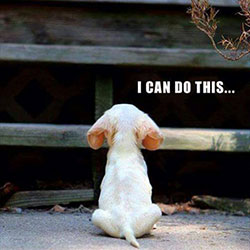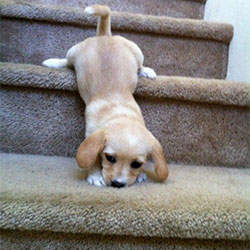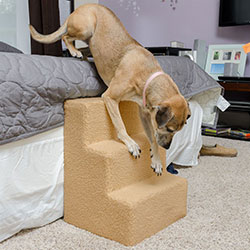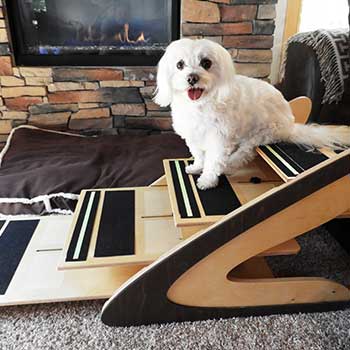Dog Steps

How to Buy Dog Stairs
There are two main problems with the typical dog stairs. The rise and the tread.The Rise – this is the height between treads. How much vertical space is your dog able to comfortably handle? And, your dog’s ability to handle this height will change from when they are a puppy to adult hood to middle age to their senior years. And yet, dog stair manufactures haven’t paid any attention to this when designing their stairs.
Rise and ...suffer?
Imagine if you had to climb up giant steps where the front edge of each step was even with your chest, or higher. That would be a struggle, wouldn’t it? Imagine doing it when you were a kid half your current size, or when you are in you 80’s. And still, most dog steps built today create this same sort of impediment for dogs. Until now the dog steps available to you use human sizes and ratios of height to depth and in doing so create a real obstacle course for your dog. That is the “rise” problem with dog steps, they aren’t designed to fit your dog, just some average height which “should work for most dogs”. Right…. My dog is not “most dogs”, how about yours?
Different Dogs Need Different Treads
Steps - The second problem is with the steps themselves. Specifically the tread depth and step positioning.
Tread depth is the amount of surface area available to the dog for placement of its paws. Too small a surface and the dog has to be careful where and how it places its steps so as to be stable and safe. Most dog stairs don’t even come close to getting this right thereby creating some comical albeit dangerous conditions for the dog.
Remember -
1) Shorter legs need a shorter rise. 2) The longer the dog the longer the tread needs to be. ...That's just common sense, right?

Putting the Pieces Together
Tread positioning is a combination of available surface area matched with the needs of dogs to have a step placement which matches their body type, as well as a slightly larger landing, or lower step. One must take into account the body length of a dog and more importantly the span between front and back legs, or where the dog naturally wants to place its paw for the next step. Older, slower dogs want tread right under their leg joints. More agile dogs like to have more tread so they can extend more.Standard dog stairs don’t take any of this into account, thereby forcing a dog into unnatural strides when moving up or down stairs. This is not only a safety issue but forces unnatural angles of use and impact upon the joints thereby leading to joint issues, pain, and mobility problems as they mature.

TheGood Steps® Difference
Good Steps are unique in that they bring together the advantages of ramps, i.e. a low angle of approach and easy on low slung dog bodies along with the shorter rise/distance of stairs and the fact that paws stay flat.
This improves stability, reduces strain on joints and ligaments, and makes it both safer and more comfortable for your dog to get to the high places. And, they adjust to each dog’s individual needs and continue to adjust throughout their life.
US & International Patents Pending | ![]() Proudly made in the U.S.A.
Proudly made in the U.S.A.

